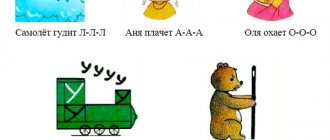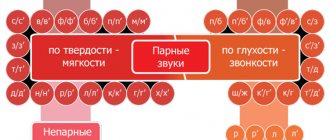Clarify the words: Russian language!
Newsletter closed
Upon closing, subscribers were transferred to the “Your Simple Business Assistant” mailing list, which we recommend that you subscribe to.
You can find mailings on similar topics in the Mailing Directory.
| October 2010 | ||||||
| 1 | 2 | 3 | ||||
| 4 | 5 | 7 | 8 | 9 | 10 | |
| 11 | 12 | 14 | 15 | 16 | 17 | |
| 18 | 19 | 21 | 22 | 23 | 24 | |
| 25 | 26 | 28 | 29 | 30 | 31 | |
Author Easy Speak Courses
Statistics
1.977 subscribers +1 per week
- Issues
- Statistics
All episodes
Yotated vowels
[td]
| Issue No. 86 dated 2010-10-20 www.clearwords.ru Number of people who received this issue: 1875 |
“For civilization to survive, it is necessary to instill in children the habit and ability to learn at school. School is not a place where children are sent so that they do not get in the way of adults during the day. It would be too expensive. School is also not designed to make parrots out of children. School is a place where learning skills are developed and where children can be prepared to face real life, taught to cope with it competently and prepared to take control of tomorrow's world, in which today's adults will be elderly people and old people "
— L. Ron Hubbard.
Letters a, y after sibilants
The use of the term "sibilant consonants" is quite common. What does it mean? These are the sounds that, when articulated, are accompanied by a characteristic hissing design. This is w, w, w, h, c
.
It should be said that initially they had a pair in softness or were always hard, but with the development of language they either lost the pair (for example, [zh], [sh]) or from originally hard they became soft ([h]).
This explains the vowel that comes after them. A standing sibilant after a vowel, as a rule, does not affect anything. So, after hissing words only a
or
y
(using
i
or
yu
is considered a gross mistake). For example: Jacqueline, jasmine, creepy, screw, shawl, sorrel, pike, thicket, seagull, heron, tsunami.
This rule does not apply to words of foreign origin, some surnames and toponyms: brochure, Jules, Qianjian, parachute, jury, Kotsyubinsky, Steponavichyus.
Definition
Yotated vowels are vowels that in certain cases make up 2 sounds (e, ё, yu, i). Accordingly: e=ye, yo=yo, yu=yu, ya=ya. Example: Yotated vowel letters always represent only two sounds.
Let's look at cases where these vowels consist of two sounds.
1. At the beginning of a word. For example, when you say the word "yama" [yama].
A few more examples when a vowel is at the beginning of a word: Hedgehog, Raccoon, Yula, Apple.
2. After vowels, for example in the word “hare” [hare].
A few more examples: application, shelter, Pelageya.
3. After the letters ъ, ь, for example in the word “blizzard” [vyuga]
More examples when a vowel comes after b or b: entry, bindweed, Natalya.
The position of the speech apparatus during the formation of consonant sounds.
Sounds B, P.
The lips are tightly closed. The tongue lies freely, the tip is at the lower incisors; with the sounds P and B, the velum is raised; a stream of exhaled air directed into the mouth breaks the closed lips, causing the sounds B and P to be formed. With the sound B, the vocal cords vibrate.
Rice. 9.
Articulation P, B: a - outside; b - inside.
Sounds V, F.
The lower lip, with its inner edge, slightly touches the upper teeth, the velum of the palate is raised, the tongue lies freely - the tip is at the lower front teeth. The air blown between the teeth and lip forms the sounds B and F. With the sound B, the ligaments vibrate.
Rice. 10.
Articulation F, V: a - outside; b - inside.
Sounds D, T, N.
The tongue is slightly raised to the palate and its front part is pressed tightly against the upper front teeth. With the sound D and N, the ligaments vibrate; with the sound D and T, the velum palatine is raised; with the sound N the velum is lowered.
Rice. eleven.
Articulation D, T, N: a - outside; b - inside.
Drooping palate with N.
Sounds K, G, X.
With the sounds K and G, the strongly arched back of the tongue touches the hard palate. The velum is raised. An exhaled stream of air breaks between the back of the tongue and the palate, this produces the explosive sounds K and G, but if there is a gap between the palate and the back of the tongue, then a long sound X is produced. The velum of the palate is raised when the sounds K, G, X are formed. With the sound G, the vocal cords vibrate.
Rice. 12.
Articulation K, G, X: a - outside; b - inside.
Sound R.
The formation of the sounds P and P soft is caused by frequent vibrations of the tip of the tongue under the influence of an exhaled stream of air. With a hard sound P, vibration occurs at the alveoli of the upper front teeth. With soft P, the tip of the tongue fluctuates near the front upper teeth. The vocal cords vibrate.
Rice. 13. A
articulation of K in combination with different vowels
Rice. 14.
Articulation P (inside)
Sound M.
The lips are slightly closed, the tongue lies freely, as with the sound A; exhaled air passes through the nose.
Rice. 15.
Articulation M
Fig.
16. Articulation L
(outside) (outside)
Sound L.
The tip of the tongue touches the upper front teeth, the root of the tongue is raised, the velum is raised, the vocal cords vibrate.
With the sound L soft, the tip of the tongue touches the upper alveoli, the entire tongue is more tense than with the sound L hard.
Sounds Z, S.
The wide tip of the tongue touches the lower teeth and partly the lower gums, and the front part of the back of the tongue with a small longitudinal groove on it rises to the upper gums and forms a narrow gap with them. The lateral edges of the tongue are pressed tightly against the upper molars. The blown air passes along the groove of the tongue between the teeth and forms sounds 3 and C. The mouth is slightly open (by three millimeters), the palate is raised; When sounding, the 3rd vocal cords vibrate. With soft 3 and C, the middle part of the back of the tongue is closer to the hard palate; in the sound, this softness is expressed in a slight increase in tone.
Rice. 17.
Articulation 3, C:
a - outside; b - inside
Sounds Zh, Sh.
The wide tip of the tongue is raised to the upper alveoli, almost to the edge of the alveoli, but does not touch the hard palate. A gap forms between the tongue and the hard palate. The lateral edges of the tongue are pressed tightly against the upper molars. The back of the back of the tongue is also raised and forms a second narrowing with the hard palate. A depression is created in the tongue (it is otherwise called a “bucket” or “cup”). The teeth are slightly apart, the lips are slightly pushed forward. With the sound Z, the ligaments vibrate.
Rice. 18.
Articulation W, F: a - outside; b - inside
Marina Vladimirovna Chekanova
Summary of the speech therapy lesson “Iotated vowels”
Chekanova M.V., teacher – speech therapist
Nefteyugansk
Preparatory group
Topic: “ Iotated vowels
»
Goal: to systematize children’s knowledge about iotized vowels
EYYUYA at the beginning of a word in a strong position.
Tasks :
Educational:
The ability to identify sounds at the beginning of a word in a strong position, denoting a combination of sounds with letters
.
Correctional and developmental:
Develop phonemic awareness through differentiation of iotated vowels
;
Develop the articulatory apparatus and fine motor skills of the fingers with the help of gymnastics with bioenergoplasty.
Educational:
Develop the ability to answer fully, listen to the answers of your comrades.
Methods:
Verbal – conversation, explanation.
Visual – multimedia presentation, stones, sounds, syllables
, elements
of letters
, models of houses with
the letters E
, E, Y, Y
Practical - performing articulations. exercises, tasks to determine the sequence of sounds, syllables
;
building letters
.
Technologies :
Health-saving (articulation, breathing exercises, physical exercises)
Computer technology (slide presentation)
Gaming (didactic games, verbal)
And or s in combination with c
Let's figure out which vowels should be written after c
.
The letter s
is written in the following cases:
- If it comes at the end of a noun or adjective. For example: three capitals, brave fellows, short fur, narrow-faced man, pickled cucumbers.
- In proper and common nouns with the suffix -yn or -tsyn-: Tsaritsyno, Golitsyn, fox tail, marten fur.
- In some exception words: gypsy (and all its derivatives), chicken, chuck, tiptoe.
In surnames and
or
ы
after
ц
is not regulated by the rule, only by title documents, which indicate the correct spelling.
Let's say that in the surnames Kunitsyn, Staritsyn it is written ы
, and Yeltsin or Vitsin must be written through
and
.
Now let's look at the cases when after c
required to use
and
. These are all those that do not fall under the rules listed above.
- Word roots (except for the exceptions listed in paragraph 3 of the previous rule). For example: figure, circus, tsigeika, specific, cylinder, Tsiolkovsky, vaccine.
- Suffixes of foreign language origin: constitution, revolution, organization, interpretation, medicine, routing, calcite.
- As a link between parts of a complex word and in abbreviations, and
: VTsIK, special interview, blitzinform.
Impact position o, e in combination with hissing
In a strong position to convey the sound [e] after hissing words you should write e
. For example: pearl, tin, whispers, rustle, crack, rubble, target, hundredweight, jaw, honor.
Vowels o/e
after the hissing ones, they obey their own rules.
First, let's look at when to write about
.
- If it is part of the ending of nouns or adjectives (barzhoy, mezhoy, shoulder, gun, stranger, big), as well as a suffix of adverbs: hot, fresh.
- If is a suffix of a noun. Let us list the variants of such morphemes: -ok- (buddy, circle, pie, jump); -onk- (little book, little piece of paper, little money, girls, boys, barrels); -onok-/-chonok- (barrel, little pebble, little hare, little badger); -onysh (as a rule, these are colloquial words: uzhonysh, little one); -ovk- (raincoat, combat jacket, small items); -about- (slum, thicket); -otk- (ratchet) and the last suffix -ovshchin- requires the ending a
: stabbing. - If it is -ov-: penny, walrus, brocade. This also includes nouns derived from these words that end in she -ovka-/-ovnik-: tsynovnik, parchovka, groshovka, grushovka, rechovka. The suffix -ov- is also often found in surnames. Here it is worth focusing on the documents given at birth. So, it can be written Borschov and Borshchev, Khrushchov and Khrushchev, Kumachov or Kumachev.
- If it is an adverb or adjective with the suffix -okhonk-: small (small), svezhokhonky (freshly). These words are colloquial.
- If is fluent in nouns and adverbs: zhor (eat); burn (burn); trouble (rozhon); intestines (intestines - genitive case).
- If the word is borrowed and the vowels after the sibilants are in its root: joker, shorts, anchovy, major, Joyce (proper names also obey this rule).
O and e in unstressed position
Regarding spelling
or
e
in an unstressed position, then you need to remember that in a weak position you should write the letter that is heard in a strong one. This applies to both roots: tin - tin; wool - wool; turn yellow - yellow; and suffixes: key, raincoat, scourge; and endings: husband, watchman, redhead.
You should remember foreign words in which in an unstressed position it is written about
: majordomo, highway, shock, lecho, Chopin, poncho, banjo and others. Their spelling should be checked with a spelling dictionary.
Progress of direct educational activities
Introductory part.
Guests have come to us, let's say hello to them.
How else can you say hello?
Good afternoon, hello, hello, nice to meet you
And yogis, for example, say hello in this position. (slide)
Who are yogis?
Let's work like yogis, only not with our feet, but with our hands and our tongues.
Articulation gymnastics
Main part.
1. Write a sentence about yogas. (SCHEME)
What does the proposal consist of? (The sentence consists of words)
How are words separated from each other? (Pauses. How many pauses, so many words)
2. Name a word that has the sound Y.
Name the first sound in the word YOGI.
Let's remember what he is like.
Than vowels
Are the sounds different from
consonant sounds
?
Physical exercise.
Divide into two teams: I-short team, vowel
.
In front of you are two trees - with red apples (models of vowel
)
and with green ones.
Whose team will pick the apples faster? Teams stand opposite each other, holding “sound-apples”
Will we be able to combine I - a short sound with vowels
?
(children's answers)
Let's find out
Look at the screen. Name the first sound in the word APPLES, the second.
Sounds of YA.
Come out those guys who have these “apple sounds”
.
Similarly with other iotized letters
HEDGEHOG, YO sound.
Skirt, sound YU.
Spruce, sound YE.
Conclusion: Has i-short merged with vowels
sounds at the beginning of a word?
What happens when we pronounce two sounds? (At first there is a slight obstacle, a stutter, and then the sound continues)
Game "Stutters"
In what cases did we hear 2 sounds in words?
3. Game “Let’s move sounds into the house”
.
Each house has its own name.
What sounds will we put in the house with the letter I?
?
(YA, Yo (YO, YU (YU)
Conclusion: Which letters
are “friendly”
the sounds YA
(with
the letter I )
4. Game “Name the words”
Name words that begin with the sounds YA (apple, yacht, Yana, Yasha)
YO (hedgehog, hedgehog, tree, ruff)
YE (spruce, raccoon, food, Emelya)
YU (Yulia, Yula, Yura, humor, young)
Final part.
What letters
are indicated by two sounds at the beginning of a word?
(E,Y,Y,Y)
Publications on the topic:
Summary of a lesson on teaching reading and speech development to preschool children “Vowels and consonants” Topic: “Vowels and consonants.” Word game. Fairy tale "Kuroch-ka-Ryaba". goal: consolidation of knowledge about the sounds of vowels and consonants, memorization.
Purpose: to clarify the similarities and differences between the vowels of the 1st and 2nd rows.
Introduce the sound composition of vowel letters of the 2nd row;
Develop phonemic awareness;
Develop skills in language analysis and synthesis;
Learn to draw conclusions, listen and understand others;
Develop memory, attention and thinking.






